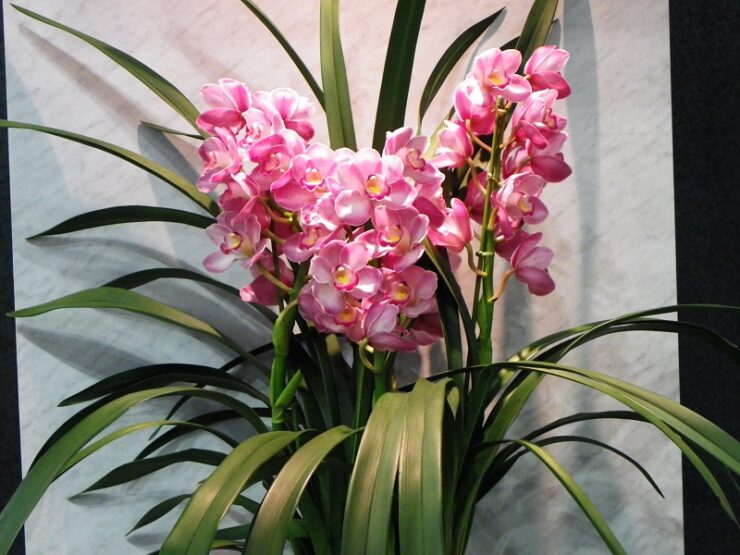Cymbidium orchids are a popular and stunning type of orchid that are often associated with the month of December. While the holly is typically considered the birth flower for December, some sources also list the Cymbidium orchid as an alternative birth flower for the month.
One reason for this connection is that they typically bloom during the winter months, making them a popular choice for holiday decorations and gifts.
The orchids come in a variety of colors, including red and green, which are traditional colors associated with Christmas and the winter season.
In addition to their beauty and association with the winter season, Cymbidium orchids also have cultural significance.
In Chinese culture, Cymbidium orchids are considered a symbol of friendship, respect, and loyalty. They are often given as gifts to friends and loved ones to show appreciation and strengthen bonds.
The Symbolism of Elegance and Luxury
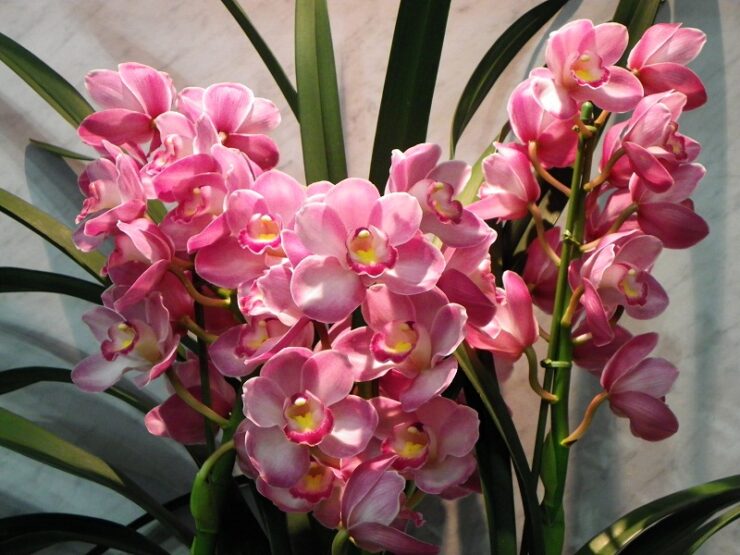
Cymbidium orchids are known for their beauty and elegance, and they are often associated with luxury and exclusivity. These orchids are native to tropical and subtropical regions of Asia, which adds to their exotic origins and rarity. They are highly sought after for their stunning blooms, which can last for several weeks and come in a variety of colors. Their long-lasting nature makes them a popular choice for special occasions and high-end events, adding a touch of sophistication and refinement to any setting.
They also have cultural significance in many parts of the world. In China, they are associated with good fortune, prosperity, and respect, while in Japan, they are believed to bring good luck and are often used in traditional tea ceremonies. Their cultural importance has further contributed to their association with elegance and luxury, making them a popular gift for those who appreciate refinement and sophistication.
Cymbidium orchids also have a long and rich history, dating back centuries. They have been highly prized for their beauty and elegance and have been used in various cultural and religious ceremonies. In addition to their ornamental value, they have also been used in traditional medicine to treat various ailments. This historical relevance has further contributed to their association with luxury and sophistication.
Today, they remain a popular choice for both ornamental and medicinal purposes. They are often used in high-end floral arrangements and can add a touch of elegance to any space. Their rarity and exotic origins, combined with their cultural significance and historical relevance, make them a symbol of luxury and refinement. Whether given as a gift or used as a decorative element, Cymbidium orchids are sure to captivate and inspire with their beauty and elegance.
When To Give Someone Cymbidium orchids
They are beautiful and meaningful gifts that can be given on a variety of occasions. Here are some times when giving someone Cymbidium orchids can be particularly appropriate:
- Birthdays: They are the birth flower for December, making them a great birthday gift for someone born in that month. However, they can also be given as a birthday gift to anyone who loves orchids or appreciates their beauty and elegance.
- Anniversaries: Cymbidium orchids are often associated with love and desire, making them a perfect gift for anniversaries, particularly milestone anniversaries such as the 25th or 50th. They can be given to a romantic partner or to a couple celebrating their anniversary.
- Weddings: Also popular choice for wedding bouquets and floral arrangements due to their beauty and elegance. Giving Cymbidium orchids as a wedding gift can be a thoughtful and meaningful way to show your appreciation and support for the couple.
- Thank You: They can also be given as a thank-you gift to show appreciation and gratitude. They can be given to a friend, family member, or colleague who has done something kind or helpful.
- Special Occasions: Cymbidium orchids can be given on other special occasions such as graduations, promotions, or retirements. They can be a thoughtful and meaningful way to mark a significant milestone or achievement.
Care
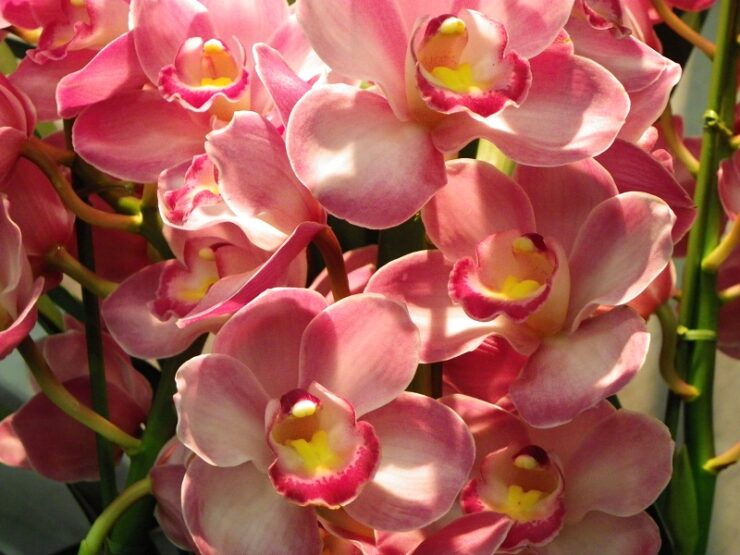
Cymbidium orchids are originally from the foothills of the Himalayas and thrive in cooler conditions. They produce tall spikes that bloom with 10 to 25 flowers, which can range in width from 2.5 to 6 inches and last from one to three months. In addition to their stunning appearance, many varieties of Cymbidium orchids are also fragrant, adding to their allure. These orchids are popular for their elegant long leaves and attractive flower types, making them a great choice as indoor plants.
Light and Shade
To ensure optimal growth of your outdoor Cymbidium, it’s important to find a spot that receives bright but diffused light. An area shaded by a pine tree or shrub during the early morning or afternoon would be ideal. Direct sunlight should be avoided as it can cause black spotting and burning of the leaves. For indoor cultivation, place the orchids in south, east, or west-facing windows to maximize exposure to filtered light.
Temperature and Humidity
Although Cymbidium orchids can be grown indoors, they thrive outdoors from May to early October. Night temperatures below 58°F (15°C) during late summer and early fall promote the growth of flower spikes. However, these plants are not frost-tolerant and should not be exposed to temperatures below 35°F (2°C). When moving them indoors during the fall, choose a bright and cool area, preferably near a south or east-facing window. To maintain healthy humidity levels, use a humidifier or humidity tray, but be careful not to let the plant stand in water and rot.
Watering
It’s important to keep the growing medium of your Cymbidium orchids moist at all times. Avoid letting it go completely dry. During sunny weather, misting the foliage in addition to watering the pot can be beneficial.
Cymbidium orchids experience active growth from spring to early fall, during which time they should be watered frequently and heavily. In fall and winter, when there’s less sun and growth slows down, reduce watering accordingly to avoid root rot. When repotting during the active growing season, wait at least 3 days before watering to allow roots to callous and avoid rotting.
For best results, water your orchids in the morning, giving the leaves enough time to dry and prevent bacterial growth overnight. Use water with low alkalinities, such as rainwater, distilled water, or reverse osmosis water whenever possible. If you have a dehumidifier at home, the water collected in the tray is excellent for watering your orchids.
Feeding
We highly recommend using Green Jungle Orchid Food to provide your Cymbidium orchids with the nutrients they would naturally encounter in their wild habitats. This fertilizer has been formulated to deliver excellent results, and we have used it ourselves for decades. For optimal results, use water low in alkalinity, such as rainwater, distilled water, or reverse osmosis water. However, you may use tap water, but mineral buildup will require more frequent repotting, typically every 1 to 2 years.
If you’re using bark mix, fertilize every time you water during the summer growing season, and flush with non-softened water once a month to rinse the media of salt and mineral buildup. During winter, fertilize every other watering, as Cymbidium orchids are not in active growth during this season. For those using sphagnum moss, fertilize every 3rd watering year-round.
Potting
Cymbidium orchids thrive in a light, porous medium that can hold moisture while draining thoroughly upon watering. We recommend potting these plants in New Zealand Sphagnum Moss or the Medium grade of our Traditional Orchid Bark Mix. It’s important to avoid disturbing the root system, so only repot when the medium has broken down. When repotting is necessary, do so in the spring after the plants have finished blooming.
Cymbidium orchids have an extensive root system and can be over-potted more easily than other orchids. When selecting a pot, make sure there is enough space for at least two years’ of growth once the plant has been placed in the center. Remove any dead or dying roots without damaging the live ones, and divide the plant if necessary.
Each section should have three or four green bulbs in addition to any new leads. To avoid the transfer of orchid diseases, sterilize all cutting and potting instruments before use by flaming pruning shears with a butane torch or spraying with rubbing alcohol and wiping with a clean paper towel.
Pest Control
Cymbidium orchids have long, thin leaves that are susceptible to tiny, almost invisible spider mites on the undersides. To avoid mites, take the plant into the shower once a month and lightly spray the foliage with room-temperature water. If you already have spider mites, spray insecticidal soap three times, one week apart, to control them.
History of Cymbidium Orchid
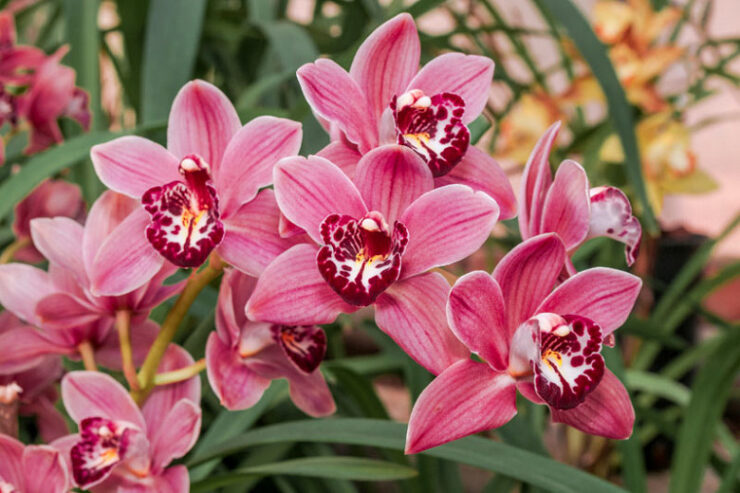
It has a rich and diverse history dating back to ancient times. The genus name Cymbidium is derived from the Greek word jumbos, meaning “hole” or “cavity,” and refers to the shape of the lip of the orchid flower.
Cymbidium orchids were highly prized by the ancient Chinese, who cultivated the plants for their beauty and medicinal properties. In fact, the Chinese have been growing Cymbidium orchids for more than 2,000 years, and they were highly valued as a symbol of nobility and wealth.
During the 19th century, British and European plant collectors began to explore the Asian continent, bringing back many exotic plant species, including the Cymbidium orchid. The orchids quickly gained popularity in Europe, with many collectors competing to acquire rare and unusual specimens.
In the early 20th century, the development of hybrid Cymbidium orchids began in earnest, leading to an explosion of new varieties with a wide range of colors, shapes, and sizes. Today, they are grown and enjoyed all over the world and are especially popular in Asia, where they continue to be highly prized for their beauty and cultural significance.
Meaning
The Greek word “orchis” which means testicles, was the origin of the name Orchids. It was the flower associated to sexuality throughout different cultures in the world. Moreover, there are more meanings associated with Orchids in its thousands of species.
The Cymbidium Orchid is a symbolism of morality, virtue, beauty, refinement, and love. To give and to receive the gift of the Cymbidium Orchid flower arrangement is such an honor. In fact, it has been considered throughout time in Asia as a gift of respect.
Origins
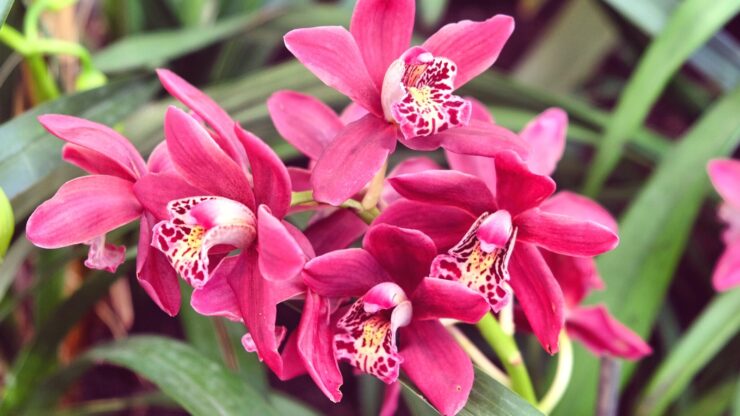
The Cymbidium orchid is native to tropical and subtropical Asia, including China, Japan, Korea, the Himalayas, and Southeast Asia. These orchids can be found growing in a variety of habitats, from sea level to high altitudes in mountainous regions.
In their native habitats, Cymbidium orchids are epiphytic or lithophytic, meaning they grow on trees or rocks, respectively. They typically grow in areas with high humidity and rainfall, and are often found near rivers or in forests.
Over the centuries, they have been cultivated and hybridized by people in many parts of Asia, including China and Japan, where they have been prized for their beauty and medicinal properties.
Today, Cymbidium orchids are grown and enjoyed by orchid enthusiasts all over the world, and are available in a wide range of colors, sizes, and shapes thanks to ongoing hybridization efforts. Despite their popularity, however, many people still find the wild, natural beauty of the Cymbidium orchid to be unmatched.
FAQs
What Does a Cymbidium Orchid Smell Like?
The scent of a Cymbidium orchid can vary depending on the specific variety and the individual plant. Some Cymbidium orchids have a sweet, pleasant fragrance, while others are not fragrant at all.
The fragrance of a Cymbidium orchid can also be influenced by environmental factors such as temperature, humidity, and light levels. For example, cooler temperatures and higher humidity levels can often enhance the scent of an orchid.
Overall, while some Cymbidium orchids may have a fragrance, it is not a defining characteristic of the species as a whole. Instead, they are primarily valued for their stunning, long-lasting flowers and their ability to thrive in a range of environments
What Happens if An Orchid Gets Too Cold?
An orchid gets too cold, it can cause damage to the plant and affect its growth and health.
Most orchids, including Cymbidiums, are tropical or subtropical plants that thrive in warm temperatures. If the temperature drops below their preferred range, usually between 60-85°F (15-29°C), the orchid may experience stress and damage.
If the temperature drops too low, the orchid can suffer from cold damage, which can manifest in several ways. The leaves may turn yellow, brown or black, and become wilted or mushy. The flowers may also become discolored or drop prematurely. Cold damage can also cause the roots to rot, leading to further stress and potentially death of the plant.
What Month Do Orchids Lose Their Flowers?
The month that orchids lose their flowers can vary depending on the specific orchid species and growing conditions. However, most orchids have a blooming period that typically lasts several weeks to a few months, after which the flowers will naturally begin to fade and eventually drop off.
For example, Cymbidium orchids typically bloom from late winter to early spring, and their flowers can last for several weeks to a few months. Phalaenopsis orchids, on the other hand, can bloom at various times throughout the year and typically have a blooming period of several weeks.
How Many Times a Year Do Orchids Bloom?
The number of times that orchids bloom per year can vary depending on the specific species and growing conditions.
Some orchids, such as Phalaenopsis, Dendrobium, and Oncidium, can bloom multiple times throughout the year if they receive the proper care and conditions. These orchids may have a resting period in between blooming periods, during which time they will not produce any flowers.
Other orchids, such as Cymbidium, typically bloom once a year, during a specific season, such as late winter or early spring. After the blooming period, the plant will typically enter a resting period and will not produce any flowers until the following year.
Conclusion
For those born in December, the Cymbidium orchid is a beautiful and fitting birth-orchid that symbolizes strength, perseverance, and endurance. Whether grown indoors or outdoors, these orchids are relatively easy to care for and can provide their owners with stunning flowers throughout the winter months.
Find out here what is a birth orchid of people born in October.
